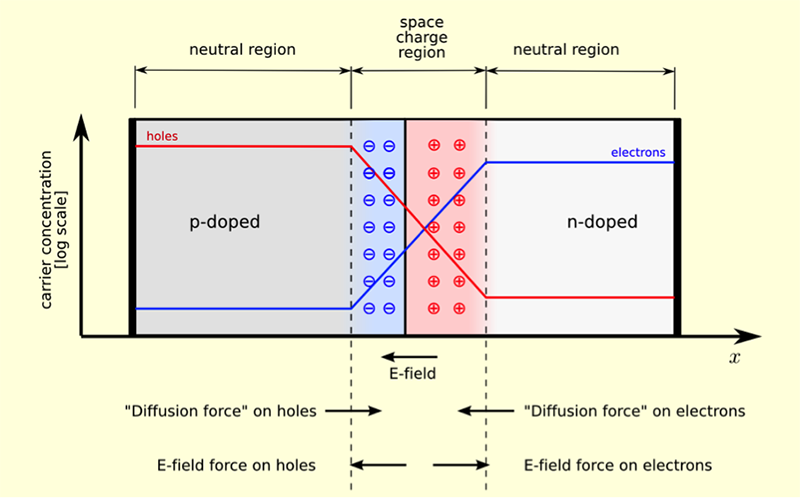Solar Cells are devices purposed to convert energy from incident light into electrical current. The incident light could be natural or artificial, however should be able to provide enough energy to create electron-hole pairs as per Semiconductor Band Theory.
However for a solar “cell” to generate a flow of electrons (current) there has to be a potential difference. To create this internal potential difference within the cell, a layer of P-type and N-type materials are added at either ends of the semiconducting material.
P-Type Material: Semiconductor doped with an element with 3 valance electrons. Leaving an extra hole to fill. P-Type end would have higher hole concentration. Example in figure: Silicon doped with Boron.
N-Type Material: Semiconductor doped with an element with 5 valence electrons. This leaves an excess electron. N-Type end would have higher concentration of electrons. Example in figure: Silicon doped with Lead.
Intrinsic Material: The naturally occurring semiconducting element or compound without any doping impurities.
![]()
Chronology of events when solar energy is incident on a solar cell
- Photon Absorption: If energy equivalent (or more) to the semiconductor’s bandgap is incident, the valence electrons absorb it to excite into the conduction band generating electron-hole pairs within the semiconductor.
- Diffusing Charges: Due to Electrostatic Force - Coulomb’s Law, the electron-hole pairs diffuses within the material without a certain direction. To generate current, we need to either apply an external potential difference or create an internal potential difference.
- Creation of In-Built Electric Field: Charges have their own Field Lines (refer Electrostatic Force - Coulomb’s Law) leading to a collective Electric Field Strength. The intrinsic semiconductor is sandwiched between a p-type and n-type materials - which leads to a positive and negative charge concentrations on either side of the semiconductor. The incident photons on the semiconductor creates a depletion region that separates positive and negative charge concentrations. This leads to an in-built electric field directed from n-type to p-type.
- Drifting Charges and Saturation Current: The current generated by drifting charges can be called as Saturation Current. Saturation Current is in opposite direction and small in magnitude compared to of the Photocurrent which is the primary output of the solar cell.
- The diffusion movement of electron-holes which is due to electrostatic force pulls electrons and holes towards the depletion region.
- Once in the depletion region, the in-built electric field pushes electrons towards the n-type end and the holes towards the p type end. The force induced by electric field is greater than the electrostatic force, which leads to electrons pushed to n-type region. This gives a directional movement for all charges, called as drifting motion.
- Generation of Photo-Voltage: The accumulation of charges on the either side and the separation provided by the depletion region creates a photo-voltage on each nodes.
- Generation of Photocurrent: On applying a load through an external circuit. The difference in photo-voltage on either side leads to forward bias (flow of electrons in a direction). This current can be quantified by the electromotive force (EMF).
If the solar cell stops receiving photons, there won’t be any new electron-hole pairs generated, leading to disappearance of the depletion region barrier. Without this barrier, we won’t have a in-built electric field that could further assist creation of EMF.
The figure below visualises the diffusion forces, the in-built electric field, and the depletion region.

Types of Solar Cells
- Single Junction
- Multi Junction:
- Quantum Dot: